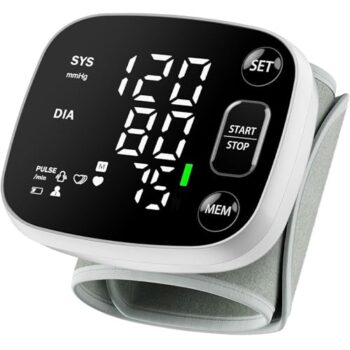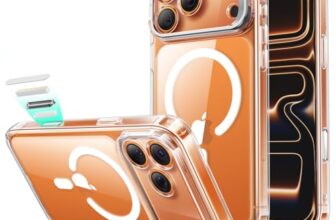Oklar Rechargeable Wrist Blood Pressure Monitor Technical Review: The Future of Convenient Home Health Monitoring
Introduction: Empowering Proactive Health with Accessible Technology
In the modern paradigm of preventative healthcare, the empowerment of the individual has become paramount. The ability to track and understand one’s own vital health metrics is no longer a luxury but a cornerstone of proactive wellness management. Among these metrics, blood pressure stands as one of the most critical indicators of cardiovascular health. For decades, home monitoring has been dominated by bulky, cumbersome upper-arm cuff devices that are often intimidating to use and inconvenient to store. This has created a significant barrier to the consistent, daily tracking that is essential for effective health management. It is this barrier that the Oklar Blood Pressure Monitor for Home Use is engineered to dismantle, not just as an alternative, but as a complete and modern reimagining of what a personal health device should be.
This is not merely a more compact version of an old technology; it is a sophisticated, user-centric diagnostic tool that prioritizes convenience, accessibility, and data integrity. Oklar has built this device around a philosophy of effortless integration into daily life. By adopting the wrist-based form factor, it dramatically enhances portability and ease of use. But the innovation goes far deeper. It replaces the endless cycle of disposable batteries with a modern, rechargeable system powered by a universal USB-C connection. It addresses the needs of users with visual impairments through a brilliant combination of a large, high-contrast LED backlit display and a clear voice broadcast function. And, most critically for long-term health tracking, it incorporates a robust dual-user memory system, allowing two individuals to meticulously log and review their readings over time. This best-selling product for 2025 has achieved its status by delivering a suite of intelligent, modern features in a package that is both incredibly affordable and remarkably easy to use. And with a limited-time 33% discount, its value proposition as an essential health tool is undeniable.
In this exhaustive technical review, we will perform a granular dissection of the technologies and design principles that define the Oklar Wrist BP Monitor. We will deconstruct the science of the oscillometric measurement method, analyze the architecture of its dual-user memory system, evaluate the real-world benefits of its accessibility features, and explore the crucial importance of proper cuff fit and user technique for achieving clinical-grade accuracy. This is a deep dive for the discerning, health-conscious individual who understands that the best tool for managing their health is one they will actually use every day.

A Deep Dive into the Key Features: A Component-by-Component Technical Analysis
The Oklar Wrist Blood Pressure Monitor’s market-leading position is not accidental. It is the result of a strategic combination of modern electronics, user-focused accessibility features, and a commitment to data management. Let’s analyze each of these core components from a technical perspective.
-
Long-Term Data Management: The Convenient Dual User Mode
A single blood pressure reading is a snapshot; a series of readings over time is a story. The Oklar monitor’s most powerful feature for long-term health management is its **Convenient Dual User Mode**. The device’s internal memory can store up to **240 total readings**, intelligently partitioned to log **120 readings for each of two distinct users**. From a data integrity standpoint, this is a critical feature for a household with two individuals monitoring their health. It prevents the commingling of data, which would render any trend analysis useless. For each measurement, the device records the systolic pressure, diastolic pressure, and pulse rate, along with the date and time of the reading. This allows each user to easily “track and compare their measurements” over days, weeks, and months. This historical data is invaluable. It allows the user and their healthcare provider to identify patterns, track the effectiveness of lifestyle changes or medications, and make more informed decisions about their cardiovascular health. The ability to recall this data directly on the device is a fundamental requirement for any serious home monitoring tool.
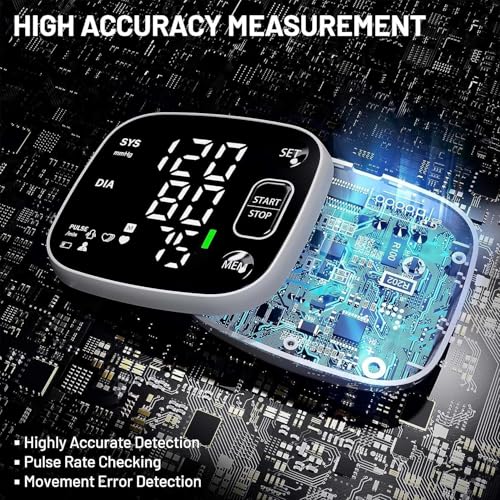
-
The Science of Measurement: Fast and Accurate Oscillometric Method
The Oklar monitor is a “fully automatic wrist blood pressure machine” that provides “fast and precise results.” The underlying technology is the **oscillometric method**, a standard in automated sphygmomanometry. From a technical standpoint, here is the process that occurs when you press the “START/STOP” button:
- Inflation: A small, quiet air pump inflates the wrist cuff to a pressure that is higher than the user’s expected systolic blood pressure, temporarily occluding the radial artery.
- Controlled Deflation: The device then begins a precisely controlled, linear deflation of the cuff pressure.
- Oscillation Detection: As the cuff deflates, a highly sensitive pressure transducer within the device detects the minute oscillations (vibrations) of the arterial wall as blood begins to flow back into the artery.
- Algorithmic Analysis: The device’s microprocessor analyzes the pattern of these oscillations. The point at which the oscillations abruptly begin to increase in amplitude corresponds to the **Systolic pressure** (the peak pressure during a heartbeat). The point at which the oscillations reach their maximum amplitude corresponds to the Mean Arterial Pressure (MAP). The point at which the oscillations rapidly diminish corresponds to the **Diastolic pressure** (the lowest pressure between heartbeats).
The entire process is completed in approximately **35 seconds**. The device’s algorithm, calibrated for wrist-based measurements, provides a fast and highly convenient reading. The **automatic power-off** after 60 seconds of inactivity is an essential power-saving feature that preserves the battery life of the rechargeable unit.
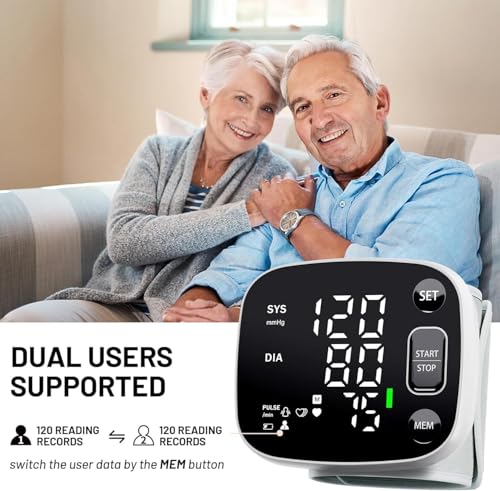
-
Accessibility by Design: The Voice Broadcast Function
A major barrier to home health monitoring for many individuals is visual impairment. Conditions like presbyopia, cataracts, or macular degeneration can make reading the small numbers on a digital display difficult or impossible. The Oklar monitor’s **Voice Broadcast Design** is a powerful and essential accessibility feature that directly addresses this challenge. When activated, a clear, synthesized voice audibly announces the user’s systolic pressure, diastolic pressure, and pulse rate upon completion of the measurement. This makes the device “ideal for individuals with poor eyesight,” ensuring they can receive their vital health information accurately and independently. The user has full control over this feature. Using the “SET” and “MEM” buttons, the user can easily adjust the volume of the broadcast or turn the function off completely if it is not needed, demonstrating a thoughtful and user-centric design.
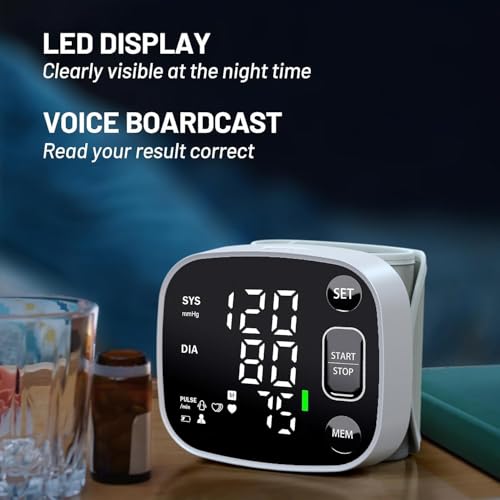
-
Superior Readability: The Large LED Backlit Display
Complementing the voice function is a large, high-visibility display. The device features a **Large LED Backlit Display**, which offers several key technical advantages over a standard, non-backlit LCD screen. An LED (Light Emitting Diode) backlight provides a bright, uniform source of illumination behind the display’s digits. This results in a much higher **contrast ratio**—the difference between the brightest white and the darkest black. This high contrast makes the “clear numbers” exceptionally easy to read, even for users with moderate visual impairments. The backlighting also means the display is perfectly readable in any ambient lighting condition, from a sunlit room to a dimly lit bedroom in the middle of the night, providing a “hassle-free visual experience.” The screen is designed to display all critical information at a glance: systolic, diastolic, pulse, user selection, and memory indicators.

-
Modern Convenience: The Portable Rechargeable System
The move away from disposable batteries is a significant upgrade in both convenience and long-term cost. The Oklar monitor is “equipped with a built-in rechargeable battery” (likely a lithium-ion or lithium-polymer cell). This provides several technical benefits. Firstly, it eliminates the recurring cost and hassle of purchasing and replacing AA or AAA batteries. Secondly, a rechargeable lithium-ion battery provides a more stable voltage output over its discharge cycle compared to alkaline batteries. This consistent power supply is beneficial for the accuracy and reliability of the sensitive electronic components, such as the pressure transducer and the air pump. Thirdly, it incorporates a modern **Type-C cable** for charging. This universal standard means the user can conveniently charge the device “anytime” using the same cable and power adapter they use for their smartphone, tablet, or laptop. This commitment to a modern, rechargeable ecosystem makes the device more sustainable, cost-effective, and convenient for daily use.
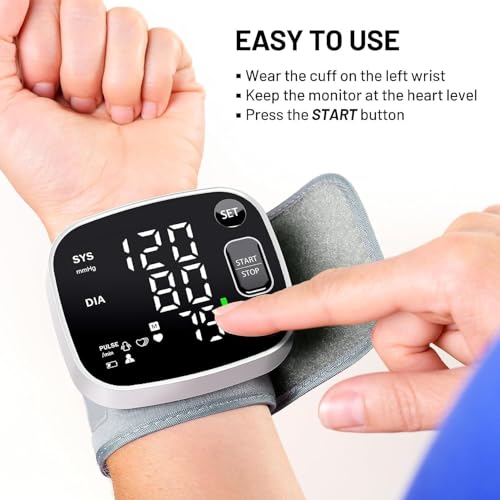
-
The Foundation of Accuracy: The Adjustable Wrist Cuff
For a wrist-based blood pressure monitor, the fit and positioning of the cuff are the most critical factors for achieving accurate measurements. The Oklar monitor features an **adjustable cuff** designed to fit a wide range of wrist circumferences, from **4.92 to 8.46 inches**. This wide range of adjustment is essential. A cuff that is too loose will result in falsely low blood pressure readings, while a cuff that is too tight can be uncomfortable and produce falsely high readings. The cuff is designed to be secured snugly, but not uncomfortably tight, providing a “more comfortable fit.” This proper fit “ensures accurate measurements” by allowing the internal bladder to apply even pressure over the radial artery. The device comes with clear instructions and diagrams that guide the user to place the cuff on their wrist correctly—typically about a half-inch from the base of the palm, with the display on the inside of the wrist—and to hold their wrist at heart level during the measurement process. This combination of a well-fitting cuff and proper user technique is the key to reliable and repeatable results.
Pros: The Undeniable Technical Strengths
- Modern and Convenient Power System: The built-in rechargeable battery with universal USB-C charging is more economical, environmentally friendly, and convenient than disposable batteries.
- Excellent Accessibility Features: The combination of a large, high-contrast LED backlit display and a clear voice broadcast function makes it exceptionally easy to use for individuals with visual impairments.
- Robust Data Tracking for Two Users: The 240-reading total memory (120 per user) with date and time stamping provides a powerful tool for long-term health monitoring and trend analysis.
- Fast, Simple, One-Touch Operation: The fully automatic process delivers a complete reading in about 35 seconds with the press of a single button, encouraging frequent use.
- Highly Portable Design: The compact wrist-based form factor and included carrying case make it easy to take on the go for travel or to bring to a doctor’s appointment.
- Excellent Value Proposition: Offers a comprehensive suite of modern, user-friendly features at a highly accessible price point, especially with current discounts.

Cons: Important Technical Considerations and Limitations
- Inherent Variability of Wrist Monitors: Wrist-based monitors are highly sensitive to body position. Users must be diligent about following instructions precisely (sitting still, feet flat on the floor, wrist at heart level) to achieve accuracy comparable to upper-arm models.
- No Bluetooth Connectivity or App Syncing: The device stores data internally but lacks Bluetooth to sync readings automatically with a smartphone health app, a feature found on more expensive models.
- Charging Adapter Not Included: While it includes a USB-C cable, the user must provide their own USB power adapter, a common but sometimes inconvenient practice.
- Potential for User Error: The accuracy is highly dependent on the user correctly positioning the cuff on their wrist. Improper placement can lead to significant measurement errors.
Conclusion: The Definitive Choice for Accessible and Modern Health Monitoring
The Oklar Rechargeable Wrist Blood Pressure Monitor is a truly exceptional product that successfully demystifies and simplifies the crucial task of home health monitoring. It stands as a powerful example of how thoughtful, user-centric design can make essential medical technology more accessible, convenient, and effective for everyone. By shedding the legacy of disposable batteries in favor of a modern USB-C rechargeable system, it aligns itself with the user’s existing tech ecosystem. Its brilliant dual-pronged approach to accessibility—a large, bright LED display paired with a clear voice broadcast—ensures that users of all visual abilities can access their health data with confidence and independence. The robust dual-user memory further elevates it from a simple measurement device to a genuine long-term health management tool.
While all wrist monitors demand a greater attention to user technique than their upper-arm counterparts, the Oklar monitor provides the clear instructions and the well-designed hardware needed to achieve reliable and consistent results. For the tech-savvy individual, the health-conscious couple, or anyone who values convenience and accessibility in their personal care devices, this monitor delivers an unparalleled combination of modern features, ease of use, and outstanding value. It has rightfully earned its status as a best-selling product and receives our highest recommendation as a top-tier choice for taking proactive control of your cardiovascular health.
Frequently Asked Questions (FAQs)
- Q1: Are wrist blood pressure monitors as accurate as the upper-arm cuff monitors my doctor uses?
- A: When used correctly, high-quality wrist monitors like this one can be very accurate. The key is proper technique. You MUST sit still, with your back supported, feet flat on the floor, and, most importantly, hold your wrist at the same level as your heart during the measurement. Upper-arm monitors are often considered more foolproof because the arm is naturally at heart level when resting on a table, but the underlying oscillometric technology is the same.
- Q2: How do I make sure my wrist is at heart level?
- A: The easiest way is to sit at a table, place the monitor on your wrist, and then rest your elbow on the table. You can use the included carrying case or a small pillow to prop your wrist up slightly so that the monitor is directly in line with the center of your chest (your heart level). You should remain in this relaxed position without talking during the entire measurement.
- Q3: How long does the rechargeable battery last on a single charge?
- A: A full charge on the built-in lithium-ion battery will typically last for several weeks or even months of regular use (e.g., one or two measurements per day). The automatic power-off feature is key to preserving the long battery life between charges.
- Q4: How do I switch between User 1 and User 2 for storing my readings?
- A: Before you take a measurement, you can typically use the “SET” or a dedicated user button on the device to toggle between the User 1 and User 2 profiles. The selected user icon will be clearly visible on the LED display. Once selected, the reading you take will be automatically saved to that user’s memory bank.
- Q5: What do the systolic and diastolic numbers mean?
- A: Blood pressure is measured in two numbers. The **Systolic** pressure (the top number) is the pressure in your arteries when your heart beats. The **Diastolic** pressure (the bottom number) is the pressure in your arteries when your heart is resting between beats. Both numbers are important indicators of your cardiovascular health, and tracking them over time is what provides the most valuable insight.
- Q6: Does this device detect an irregular heartbeat (arrhythmia)?
- A: Many modern digital blood pressure monitors include an irregular heartbeat detector (IHB) icon. While the key features do not explicitly list it, it is a common function. If the device detects an irregular rhythm during the measurement, a special symbol (often a heart with waves around it) will appear on the display. This can be an important piece of information to discuss with your doctor.
See more posts in the category Health.
